Yamaha Smax Top Speed
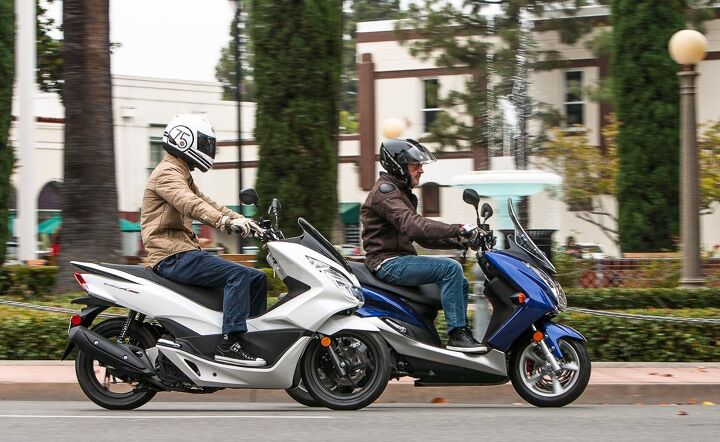
- Go Back
Photos by: Evans Brasfield
Some states, California for one, require that a scooter be 150cc or more in order to be ridden legally on highways. While some smaller-displacement scooters can reach the minimum speeds required to run with the traffic, these two are equipped to meet the requirements of the law in addition to speed. On the occasion of the release of the Yamaha SMAX and an incremental update of the Honda PCX150, we decided we should test the newest members of the 150cc highway hoppers.
2013 Honda PCX150 Review
The format for this scootout was simple: Use the contestants in the pursuit of the daily tasks for which they were designed. (After weeks of flogging superbikes on the track and in the streets, this was kind of a nice respite.) So, sit yourself down and hang your grocery bag on the thoughtfully included hook (on the SMAX) or recharge your phone (on the PCX). We're ready to…uh…transport ourselves in an extremely practical – yet fun – manner.
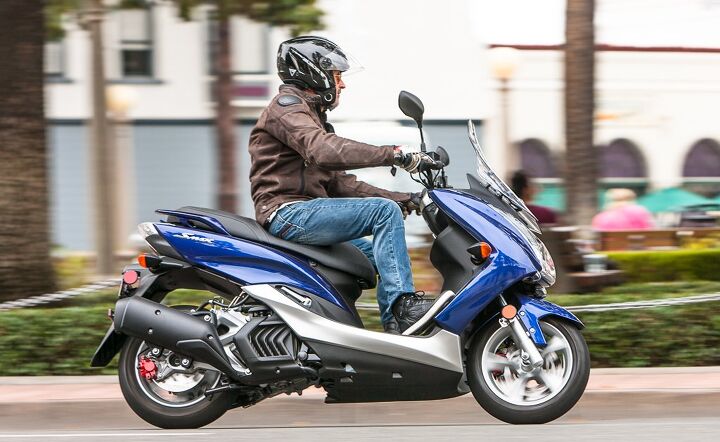
The Yamaha SMAX features the classic scooter step-through design while the Honda PCX utilizes the less common step over.
New Kids On the Block
Since its release in 2013, the PCX150 has become one of Honda's worldwide best-sellers. For 2015, the popular scooter received some updates. LED lighting was added, including the dual headlights, brake, and signals. A convenient 12-volt charging port was inserted into the waterproof but non-lockable front storage compartment. The 153cc engine's efficiency was improved via internal friction-reduction efforts. The tank capacity was bumped by half a gallon to 2.1 gal., providing a nice increase to the PCX's range to 200 mi., based on our tested 95.4 mpg. Since thrifty transportation is what scooters in this class are all about, these changes alone would attract attention – all for the unchanged $3,499 MSRP.

Tony Colombini, owner of Blacktop Depot, found our scoots interesting enough to let us shoot them amongst his vintage memorabilia. The PCX seems to be enjoying itself.
The Yamaha SMAX, a new-for-2015 model, steps onto the stage for $3,690 – almost exactly $200 more than the PCX. Boasting a 155cc single-cylinder engine, the SMAX doubles the number of valves operated by its SOHC compared to the PCX's two poppets. The Yamaha comes up 0.1 gal. short in the fuel carrying department – though it wins bonus points for the easy-to-use fuel filler located on the left side of the fairing. You'll be visiting the gas station a little bit more frequently on the SMAX – about every 160 mi. – based on 76.3 mpg we averaged.
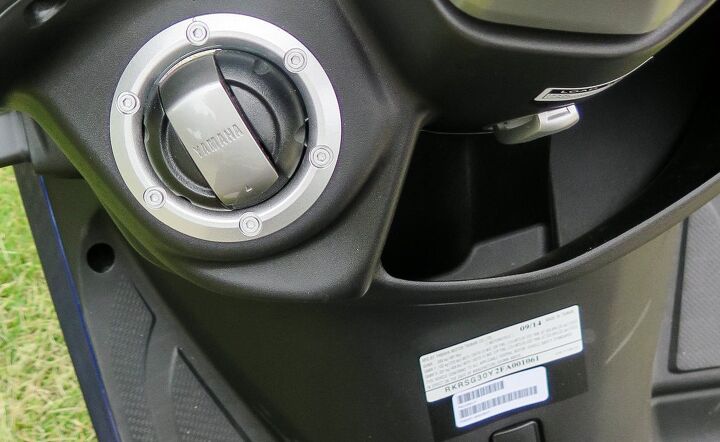
Yamaha located the gas filler conveniently on the SMAX. The grocery bag hook is on the top right.
The first time you start the PCX, you'll encounter the scooter's one true annoyance – one that becomes more grating over time. A spring-loaded shutter covers the ignition key slot, requiring that you insert the top of the key, rotate the shutter, insert the key into the ignition, and, finally, switch on the scooter. A workaround is leaving the fork unlocked, which keeps the shutter from snapping closed, making the bike more vulnerable to theft because of the inconvenience of an anti-theft feature. The SMAX has no such issues.
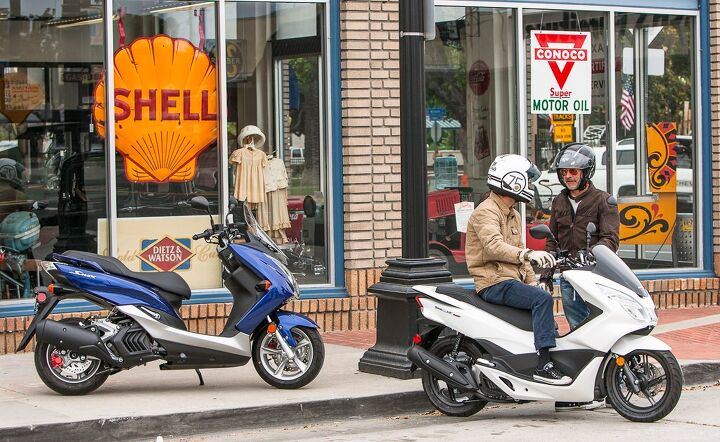
Downtown Shuffle
Carping about first-world problems aside, the PCX quietly starts with a squeeze of the brake lever and a push of a button. Rolling on the throttle produces a surprisingly quick engagement of the CVT belt system and forward motion. This perky throttle response is appreciated in urban settings where getting a jump on the four-wheeled traffic is always nice. Once you're rolling, the PCX powers around with the forward thrust you'd expect from a 150 producing a claimed 13.5 hp.
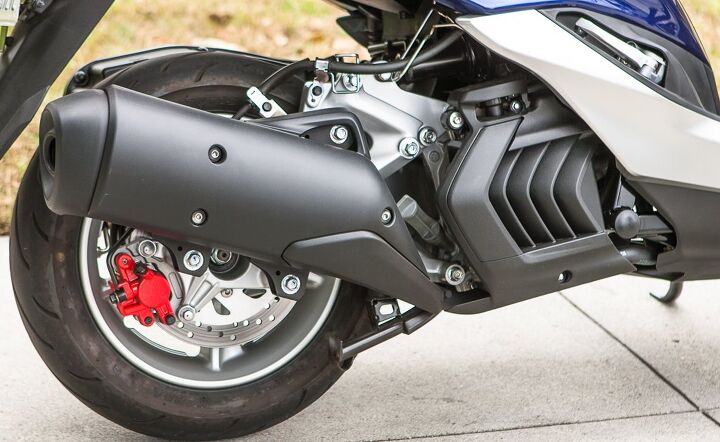
Both the Honda and Yamaha hide their radiators behind a set of gills on the lower right side. The SMAX's are larger and angrier looking.
The Yamaha is just as easy to get underway but displays a slightly different character when pulling away from a stop. While the acceleration feels almost identical to the PCX, a slight delay from opening the throttle to forward motion causes the SMAX to feel sluggish off the line. Still, in our informal stoplight drag races, the pair remained neck-and-neck with no clear advantage. Scooter Grocery Correspondent John Burns gave the nod to the Yamaha: "The PCX has a slightly smoother, less coarse engine, but I like everything else about SMAX better."
2015 Yamaha Smax First Ride Review
One area where the Honda has a clear advantage is in maneuverability. Ironically, the Yamaha is quicker steering – to the point of being flighty – while the Honda's still-scooter-quick steering feels slightly more planted. In the case of these scooters, stable was more confidence inspiring. The PCX's 14-in. wheels compared to the SMAX's 13-inchers, no doubt, have something to do with this. Surprisingly, at highway speeds both scoots remain quite stable at their maximum velocity. The suspensions behave with remarkable similarity. "They both seem to have decent suspension right up until you hit a good-sized bump," sayeth Burns.
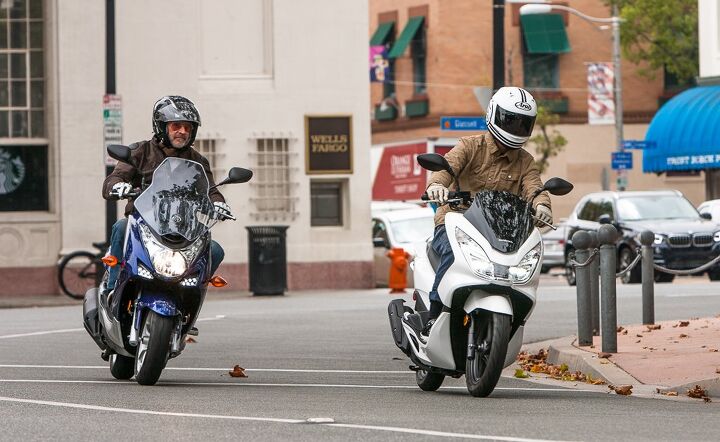
The Challenge of the Open Road
Just because these scooters are legally allowed to go on the highway, doesn't mean they are really good at it. Yes, the SMAX is able to exceed the legal speed limit in almost every one of the 50 states, but on a couple of occasions, I had car drivers actually slow down to let me merge into the right-hand lane because I was running out of acceleration lane. Getting up to highway cruising speed is better timed with a day planner than a watch. Once out on the freeway, maintaining momentum is the rider's primary task – because if you roll off the throttle significantly, you risk becoming a rolling chicane for impatient drivers.
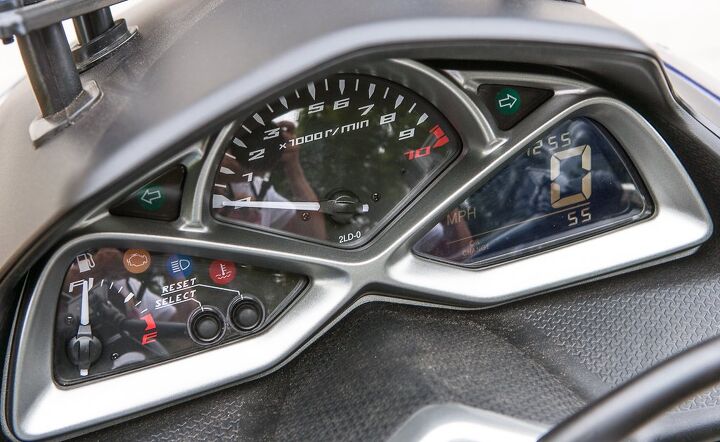
Expect to see the SMAX's tachometer needle near the red zone at highway speeds.
Now, we come to the issue that will make the Yamaha the clear winner of this duo if traveling on highways will be any part of your scooter's job description. The Honda PCX is limited to an indicated 63 mph. Yes, this is below the commonly posted 65-mph limit on many highways. The engine pulls consistently right up to 63, and then nothing can make it go any faster. In fact, it exhibits a strange pulsing behavior where the engine power goes on and off – repeatedly – while the speed doesn't change, leading us to believe it is speed-limited rather than bumping up into its rev limit. Why Honda would place such low limits on the PCX is beyond us.
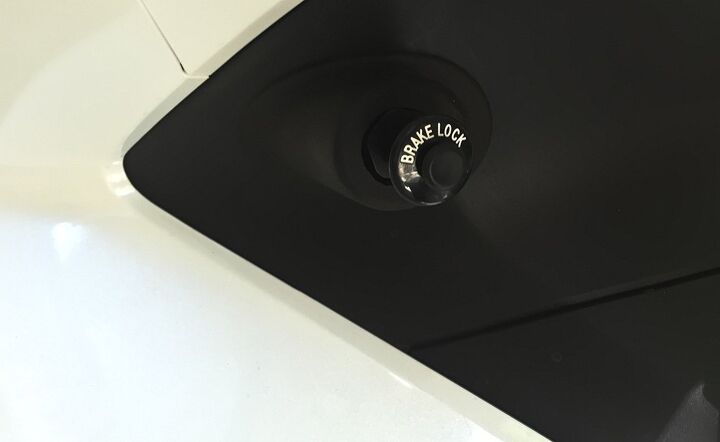
The PCX and SMAX both have parking brakes for those so inclined.
When we asked Honda about the demonstrable difference in top speed from when we tested it in 2012, we were informed that there had been no mechanical changes to the powerplant that could account for this. We know that we are not alone in experiencing this lowered top speed and have read discussions about it in scooter forums. At press time, Honda had not verified that the PCX has a speed limiter, though the rep says most bikes in this category are limited.
+ Highs
| – Sighs
|
The SMAX, on the other hand, accelerates all the way up to about 77 mph, and then the power tails off, with the top speed settling in between 79–81 mph (indicated). Drafting a tractor-trailer downhill can get the speedo to briefly jump to 82, while even the slightest upward incline causes the speed to drop into the mid-to-low 70s. This shouldn't come as a surprise when you consider that the SMAX has a claimed maximum of 14.8 hp available to it at 7,500 rpm. If you want to ride on the highway at all, the SMAX will have you spending less time watching your rear-view mirrors than the Honda.
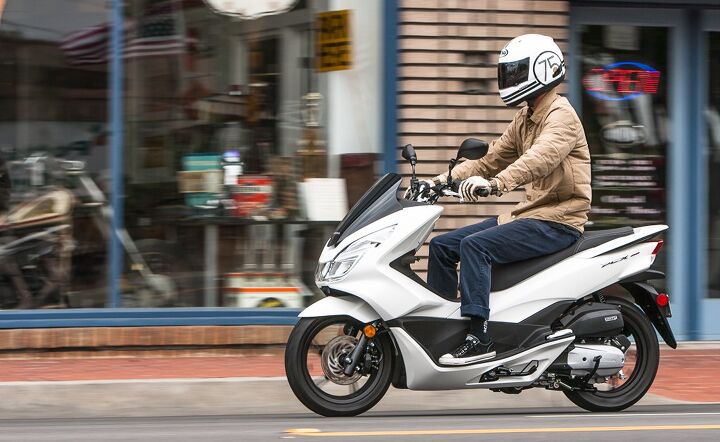
Though both bikes accelerate at about the same pace, the PCX feels snappier off the line – a boon in the urban world in which it will live.
The rider accommodations are on the small side, with both seats having bolsters, which according to Burns, "makes even me feel a tad cramped at 5-foot-8. I think the SMAX is the tiniest of the two. Okay for around town, but I know the PCX isn't too comfy for more than an hour at a time."
Although an hour in the saddle is a bit much for the PCX, the legs attached to my 32-in. inseam were fidgety after about 15 minutes folded up on the SMAX with no real room for adjustment. This is really too bad since my upper body was comfy on both bikes. Despite their differing approaches to wind protection, the Honda's shorty windshield does an impressive job of directing the wind blast away from the rider's torso at highway speeds. The SMAX's taller windshield provides slightly more wind protection without buffeting.
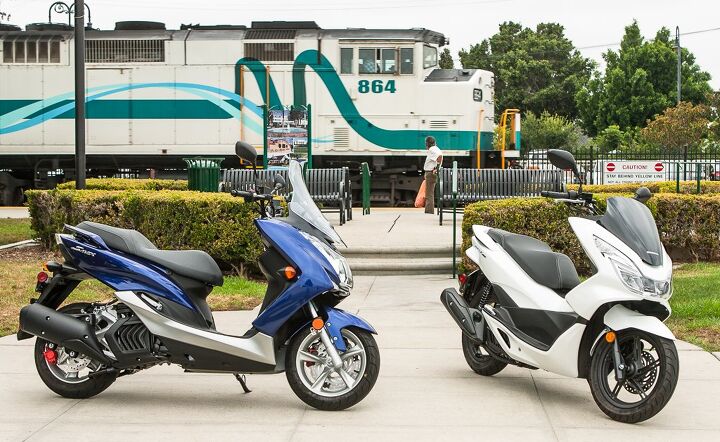
Daily Driver
Both bikes excel in the mundane task of carrying a rider and groceries or school books or some other small essentials for short distances with a minimum of fuss. They go quickly enough, in most situations. They're maneuverable enough to get around most of the obstacles you're likely to encounter. They stop adequately, though Burns notes the SMAX has "much better brakes, with front and rear discs with cool red calipers!" Neither has ABS, but the PCX has CBS (Combined Brake System) that links the rear drum to the front caliper through some kind of black magic.
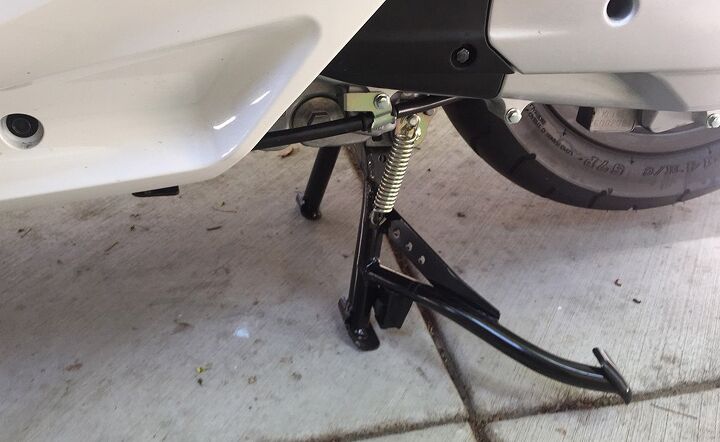
"At least they both have centerstands, so you can warm them up for 15 seconds while you put on gloves and helmet before flogging them around to the Piggly-Wiggly." – John "Sooie" Burns
Every facet where these scoots shine is a functional task rather than something flashy or performance oriented. The instrumentation delivers the basics of information, though each gets a nod for a nice feature above and beyond what you'd expect at this price point: the PCX for the cool speedo with its analog needle emerging from the outside of the dial; the SMAX for having a big analog tachometer. Yes, a tach is paradoxical on a scooter, but there's still something satisfying about seeing the needle buried in the red zone – even if the speed is only 81 mph.
+ Highs
| – Sighs
|
When the point tallying began, we thought the result was a foregone conclusion. Even though there were many things we liked about the PCX, it had a few niggles and one glaring issue. Still, its lower price, lighter weight, better weight to power ratio made the result a squeaker on the scorecard, with the Yamaha winning by 0.4%. The 63-mph speed limit drastically limited the Honda's chances. Bummer. That's not to say the SMAX didn't have issues, too. However, the Yamaha did almost everything just as well as the PCX and outperformed the Honda in a couple key places.
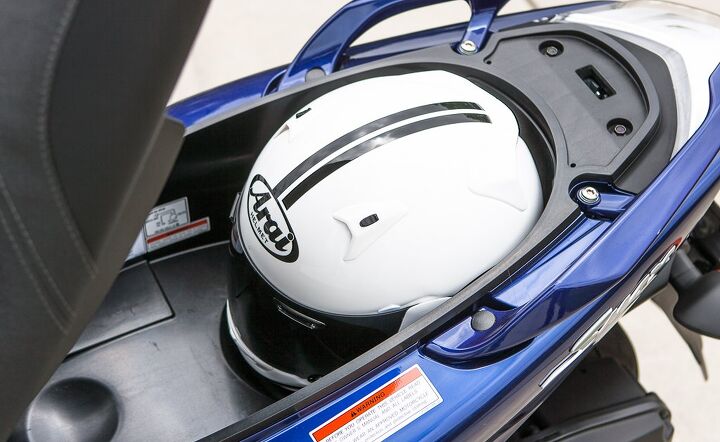
Both scoots have enough underseat storage to hold a full-faced helmet, but the SMAX required a little more fiddling to get the latch to close.
Still, the utility of both of these scooters can't be overlooked. We'll let Burns pontificate us out of this shootout.
"I love having either one around the house. The car stays parked while the scooter takes care of all the constant errands: fish food, printer ink, two bottles of cheap plonk, sesame oil, a green burrito from Del Taco, a quick blast to Barnes & Noble. Oi, we're out of coffee at 6 am… The PCX was full when I picked it up from Honda many weeks ago, and I have ridden it to the beach and a bunch of other places, and did not put gas in until this morning: 1.95 gallons for 186 miles."
| Highway Hopper Scootout Scorecard | |||
| Category | Honda PCX | Yamaha SMAX | |
|---|---|---|---|
| Price | 100.0% | 94.8% | |
| Weight | 100.0% | 87.2% | |
| Engine | 76.3% | 78.8% | |
| lb/hp | 100.0% | 95.5% | |
| lb/lb-ft | 100.0% | 87.4% | |
| Transmission/Clutch | 85.0% | 77.5% | |
| Handling | 86.3% | 83.8% | |
| Brakes | 72.5% | 82.5% | |
| Suspension | 65.0% | 65.0% | |
| Technologies | 50.0% | 60.0% | |
| Instruments | 60.0% | 72.5% | |
| Ergonomics/Comfort | 70.0% | 67.5% | |
| Quality, Fit & Finish | 85.0% | 86.3% | |
| Cool Factor | 68.8% | 62.5% | |
| Grin Factor | 63.8% | 70.0% | |
| Overall Score | 77.3% | 77.7% | |
| Highway Hopper Scootout Spec Sheet | |||
| Honda PCX | Yamaha SMAX | ||
|---|---|---|---|
| MSRP | $3,499.00 | $3,690 | |
| Type | 153 cc,liquid-cooled single-cylinder four-stroke | 155 cc,liquid-cooled single cylinder four-stroke | |
| Fuel System | PGM-FI with automatic enrichment | EFI | |
| Valve Train | SOHC, two valves | SOHC, four valves | |
| Transmission | Honda V-Matic belt-converter automatic transmission | Automatic CVT | |
| Final Drive | Belt | Belt | |
| Front Suspension | 31mm hydraulic fork; 3.9 inches of travel | 33mm fork; 3.1 in of travel | |
| Rear Suspension | Twin shock, 3.0 inches of travel | Mid ship horizontal positioned rear shock, 3.6 in of travel | |
| Front Brake | Single 220mm disc with three-piston caliper and CBS | Single 267mm disc, 2-piston caliper | |
| Rear Brake | Drum with CBS | Single 245mm disc, single-piston caliper | |
| Front Tire | 90/90-14 | 120/70-13 | |
| Rear Tire | 100/90-14 | 130/70-13 | |
| Wheelbase | 51.8 in. | 55.3 in. | |
| Seat Height | 29.9 in. | 31.3 in. | |
| Claimed Weight (Ready to Ride) | 286 lb. | 328 lb. | |
| Fuel Capacity | 2.1 gal. | 2.0 gal. | |
| Tested Fuel Economy | 95.4 mpg | 76.3 mpg | |
| Available Colors | 2015: Metallic Black, Pearl White; 2016: Dark Candy Red, Steel Grey | Matte Titan, Ultramarine Blue | |
| Warranty | Transferable, unlimited-mileage limited warranty | 1 Year (Limited Factory Warranty) | |
Source: https://www.motorcycle.com/shoot-outs/highway-hopper-scootout

0 Komentar